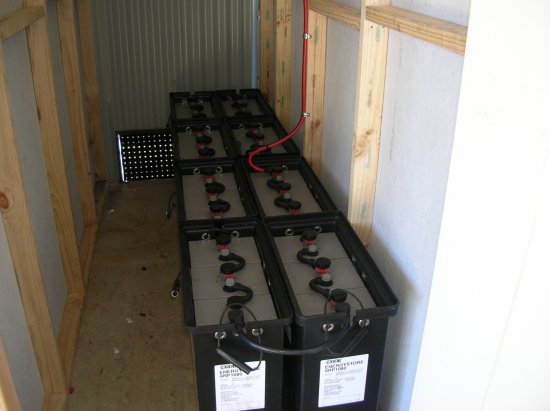|
Supercapacitor Home Energy Storage
Unit |
 |
|
Most off-grid home power
systems use a large bank of lead-acid batteries to store excess power produced during
daylight hours for later use at night. Some of these battery banks are massive, able
to power the homeís electrical loads for many days. Can existing supercapacitor
technology be useful for storing electrical energy for a home? Letís explore
this and see if it is technically feasible. |
| I imagine a big
freezer size energy storage unit which resembles the small shed shown below, parked
some place in the corner of a basement. Housed inside the unit would be a large
bank of supercapacitors, similar to the Maxwell units shown below. The storage
box might be 6 feet wide, 4 feet deep and 8 feet high. That would put the total
volume at nearly 200 cubic feet. The supercapacitors would be charged by drawing
power from photovoltaic solar panels, from wind generators or from a gasoline powered
generator. At night, DC would be drawn from the supercapacitors to feed a DC to AC
inverter. The inverter would supply power to the electrical loads of the house.
Just how much energy could such a box store using the best of supercapacitor
technology available today? |
|
|
| The Maxwell capacitor bank modules
shown above are made of individual capacitors. Each has a rating of 3000
farads with a maximum voltage of 2.7 volts each. They are 2.39 inches in
diameter and 5.43 inches long for a volume of 24.3 cubic inches. There are
1728 cubic inches in a cubic foot so each device has a volume of 0.014 cubic
feet. When fully charged, how much energy does one of these devices store?
The equation for the energy stored in a capacitor is: E = Ĺ CV^2 where E is the
energy in joules, C is the capacitance in farads and V is the voltage in volts.
So, these 3000 farad devices charged to 2.7v will store 10,935 joules. |
 |
|
|
 |
The volume energy
storage density of these would then be 450 joules per cubic inch or 778,000
joules per cubic foot. If we crammed as many of these things as possible
in our 200 cubic foot storage unit, we could store 155M joules of energy.
A watt-hour is equal to 3600 joules, so the shed like energy storage unit could
hold 43,055 watt-hours. The typical house uses about 25,000 watt-hours per
day, so the storage unit could store enough energy for about two days of
electrical energy needs. Not bad! But, it would take about 14,300 of
these capacitors to fill the shed. At roughly $80 each, the total cost
would be $1.1M. That is a bit high. |
| To equal this kind of energy
storage, a lead-acid storage battery would have to be rated at about 48v and
1000 Amp-hours. Such a battery would certainly be big but not nearly as
big as our hypothetical capacitor bank. The real advantage of the capacitor bank
is that it could handle 1000s of charge/discharge cycles and last perhaps 10 to
15 years. Most batteries are only good for about 5 years. |
|
| So, in
conclusion, it would be possible to store a reasonable amount of energy in a box like
case to power a home for a couple days but the cost is not practical today. The cost
is coming down on these devices. The energy storage density is also getting better.
Already, some supercapacitor companies claim an energy density twice that of Maxwell.
As these things scale up the production costs should come way down. |
|
|